Ze Chen
Taylor expansion-based Kolmogorov-Arnold network for blind image quality assessment
May 27, 2025Abstract:Kolmogorov-Arnold Network (KAN) has attracted growing interest for its strong function approximation capability. In our previous work, KAN and its variants were explored in score regression for blind image quality assessment (BIQA). However, these models encounter challenges when processing high-dimensional features, leading to limited performance gains and increased computational cost. To address these issues, we propose TaylorKAN that leverages the Taylor expansions as learnable activation functions to enhance local approximation capability. To improve the computational efficiency, network depth reduction and feature dimensionality compression are integrated into the TaylorKAN-based score regression pipeline. On five databases (BID, CLIVE, KonIQ, SPAQ, and FLIVE) with authentic distortions, extensive experiments demonstrate that TaylorKAN consistently outperforms the other KAN-related models, indicating that the local approximation via Taylor expansions is more effective than global approximation using orthogonal functions. Its generalization capacity is validated through inter-database experiments. The findings highlight the potential of TaylorKAN as an efficient and robust model for high-dimensional score regression.
ROUTE: Robust Multitask Tuning and Collaboration for Text-to-SQL
Dec 13, 2024



Abstract:Despite the significant advancements in Text-to-SQL (Text2SQL) facilitated by large language models (LLMs), the latest state-of-the-art techniques are still trapped in the in-context learning of closed-source LLMs (e.g., GPT-4), which limits their applicability in open scenarios. To address this challenge, we propose a novel RObust mUltitask Tuning and collaboration mEthod (ROUTE) to improve the comprehensive capabilities of open-source LLMs for Text2SQL, thereby providing a more practical solution. Our approach begins with multi-task supervised fine-tuning (SFT) using various synthetic training data related to SQL generation. Unlike existing SFT-based Text2SQL methods, we introduced several additional SFT tasks, including schema linking, noise correction, and continuation writing. Engaging in a variety of SQL generation tasks enhances the model's understanding of SQL syntax and improves its ability to generate high-quality SQL queries. Additionally, inspired by the collaborative modes of LLM agents, we introduce a Multitask Collaboration Prompting (MCP) strategy. This strategy leverages collaboration across several SQL-related tasks to reduce hallucinations during SQL generation, thereby maximizing the potential of enhancing Text2SQL performance through explicit multitask capabilities. Extensive experiments and in-depth analyses have been performed on eight open-source LLMs and five widely-used benchmarks. The results demonstrate that our proposal outperforms the latest Text2SQL methods and yields leading performance.
Class Balance Matters to Active Class-Incremental Learning
Dec 09, 2024
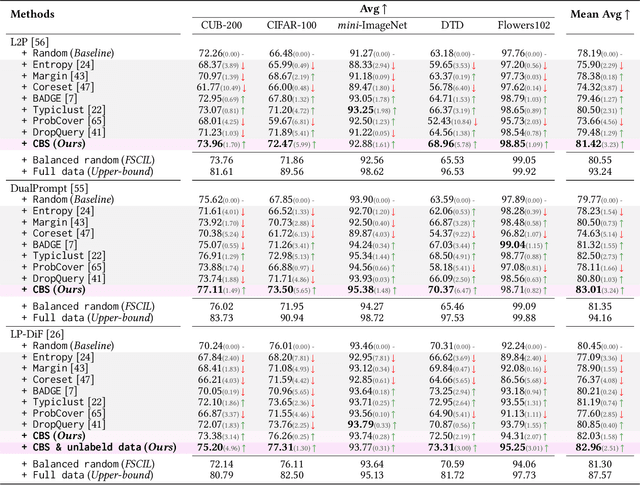

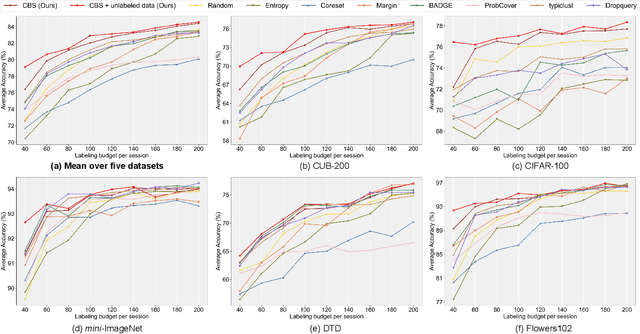
Abstract:Few-Shot Class-Incremental Learning has shown remarkable efficacy in efficient learning new concepts with limited annotations. Nevertheless, the heuristic few-shot annotations may not always cover the most informative samples, which largely restricts the capability of incremental learner. We aim to start from a pool of large-scale unlabeled data and then annotate the most informative samples for incremental learning. Based on this premise, this paper introduces the Active Class-Incremental Learning (ACIL). The objective of ACIL is to select the most informative samples from the unlabeled pool to effectively train an incremental learner, aiming to maximize the performance of the resulting model. Note that vanilla active learning algorithms suffer from class-imbalanced distribution among annotated samples, which restricts the ability of incremental learning. To achieve both class balance and informativeness in chosen samples, we propose Class-Balanced Selection (CBS) strategy. Specifically, we first cluster the features of all unlabeled images into multiple groups. Then for each cluster, we employ greedy selection strategy to ensure that the Gaussian distribution of the sampled features closely matches the Gaussian distribution of all unlabeled features within the cluster. Our CBS can be plugged and played into those CIL methods which are based on pretrained models with prompts tunning technique. Extensive experiments under ACIL protocol across five diverse datasets demonstrate that CBS outperforms both random selection and other SOTA active learning approaches. Code is publicly available at https://github.com/1170300714/CBS.
Exploring Kolmogorov-Arnold networks for realistic image sharpness assessment
Sep 12, 2024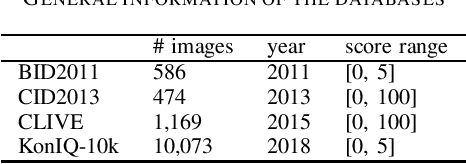



Abstract:Score prediction is crucial in realistic image sharpness assessment after informative features are collected. Recently, Kolmogorov-Arnold networks (KANs) have been developed and witnessed remarkable success in data fitting. This study presents Taylor series based KAN (TaylorKAN). Then, different KANs are explored on four realistic image databases (BID2011, CID2013, CLIVE, and KonIQ-10k) for score prediction by using 15 mid-level features and 2048 high-level features. When setting support vector regression as the baseline, experimental results indicate KANs are generally better or competitive, TaylorKAN is the best on three databases using mid-level feature input, while KANs are inferior on CLIVE when high-level features are used. This is the first study that explores KANs for image quality assessment. It sheds lights on how to select and improve KANs on related tasks.
Category-Extensible Out-of-Distribution Detection via Hierarchical Context Descriptions
Jul 23, 2024Abstract:The key to OOD detection has two aspects: generalized feature representation and precise category description. Recently, vision-language models such as CLIP provide significant advances in both two issues, but constructing precise category descriptions is still in its infancy due to the absence of unseen categories. This work introduces two hierarchical contexts, namely perceptual context and spurious context, to carefully describe the precise category boundary through automatic prompt tuning. Specifically, perceptual contexts perceive the inter-category difference (e.g., cats vs apples) for current classification tasks, while spurious contexts further identify spurious (similar but exactly not) OOD samples for every single category (e.g., cats vs panthers, apples vs peaches). The two contexts hierarchically construct the precise description for a certain category, which is, first roughly classifying a sample to the predicted category and then delicately identifying whether it is truly an ID sample or actually OOD. Moreover, the precise descriptions for those categories within the vision-language framework present a novel application: CATegory-EXtensible OOD detection (CATEX). One can efficiently extend the set of recognizable categories by simply merging the hierarchical contexts learned under different sub-task settings. And extensive experiments are conducted to demonstrate CATEX's effectiveness, robustness, and category-extensibility. For instance, CATEX consistently surpasses the rivals by a large margin with several protocols on the challenging ImageNet-1K dataset. In addition, we offer new insights on how to efficiently scale up the prompt engineering in vision-language models to recognize thousands of object categories, as well as how to incorporate large language models (like GPT-3) to boost zero-shot applications. Code will be made public soon.
Educating LLMs like Human Students: Structure-aware Injection of Domain Knowledge
Jul 23, 2024



Abstract:This paper presents a pioneering methodology, termed StructTuning, to efficiently transform foundation Large Language Models (LLMs) into domain specialists. It significantly minimizes the training corpus requirement to a mere 0.3% while achieving an impressive 50% of traditional knowledge injection performance. Our method is inspired by the educational processes for human students, particularly how structured domain knowledge from textbooks is absorbed and then applied to tackle real-world challenges through specific exercises. Based on this, we propose a novel two-stage knowledge injection strategy: Structure-aware Continual Pre-Training (SCPT) and Structure-aware Supervised Fine-Tuning (SSFT). In the SCPT phase, we organize the training data into an auto-generated taxonomy of domain knowledge, enabling LLMs to effectively memorize textual segments linked to specific expertise within the taxonomy's architecture. Subsequently, in the SSFT phase, we explicitly prompt models to reveal the underlying knowledge structure in their outputs, leveraging this structured domain insight to address practical problems adeptly. Our ultimate method has undergone extensive evaluations across model architectures and scales, using closed-book question-answering tasks on LongBench and MMedBench datasets. Remarkably, our method matches 50% of the improvement displayed by the state-of-the-art MMedLM2 on MMedBench, but with only 0.3% quantity of the training corpus. This breakthrough showcases the potential to scale up our StructTuning for stronger domain-specific LLMs. Code will be made public soon.
Rethinking Out-of-Distribution Detection on Imbalanced Data Distribution
Jul 23, 2024Abstract:Detecting and rejecting unknown out-of-distribution (OOD) samples is critical for deployed neural networks to void unreliable predictions. In real-world scenarios, however, the efficacy of existing OOD detection methods is often impeded by the inherent imbalance of in-distribution (ID) data, which causes significant performance decline. Through statistical observations, we have identified two common challenges faced by different OOD detectors: misidentifying tail class ID samples as OOD, while erroneously predicting OOD samples as head class from ID. To explain this phenomenon, we introduce a generalized statistical framework, termed ImOOD, to formulate the OOD detection problem on imbalanced data distribution. Consequently, the theoretical analysis reveals that there exists a class-aware bias item between balanced and imbalanced OOD detection, which contributes to the performance gap. Building upon this finding, we present a unified training-time regularization technique to mitigate the bias and boost imbalanced OOD detectors across architecture designs. Our theoretically grounded method translates into consistent improvements on the representative CIFAR10-LT, CIFAR100-LT, and ImageNet-LT benchmarks against several state-of-the-art OOD detection approaches. Code will be made public soon.
ESOD: Efficient Small Object Detection on High-Resolution Images
Jul 23, 2024



Abstract:Enlarging input images is a straightforward and effective approach to promote small object detection. However, simple image enlargement is significantly expensive on both computations and GPU memory. In fact, small objects are usually sparsely distributed and locally clustered. Therefore, massive feature extraction computations are wasted on the non-target background area of images. Recent works have tried to pick out target-containing regions using an extra network and perform conventional object detection, but the newly introduced computation limits their final performance. In this paper, we propose to reuse the detector's backbone to conduct feature-level object-seeking and patch-slicing, which can avoid redundant feature extraction and reduce the computation cost. Incorporating a sparse detection head, we are able to detect small objects on high-resolution inputs (e.g., 1080P or larger) for superior performance. The resulting Efficient Small Object Detection (ESOD) approach is a generic framework, which can be applied to both CNN- and ViT-based detectors to save the computation and GPU memory costs. Extensive experiments demonstrate the efficacy and efficiency of our method. In particular, our method consistently surpasses the SOTA detectors by a large margin (e.g., 8% gains on AP) on the representative VisDrone, UAVDT, and TinyPerson datasets. Code will be made public soon.
CARES: A Comprehensive Benchmark of Trustworthiness in Medical Vision Language Models
Jun 10, 2024

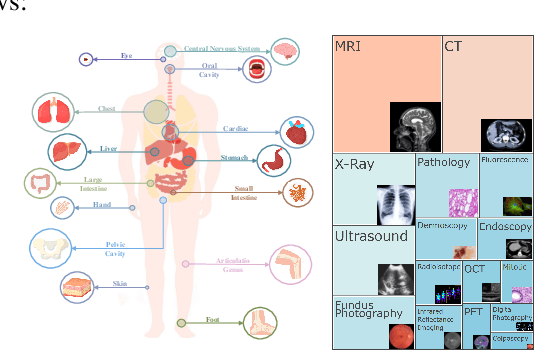
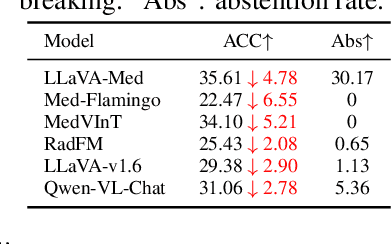
Abstract:Artificial intelligence has significantly impacted medical applications, particularly with the advent of Medical Large Vision Language Models (Med-LVLMs), sparking optimism for the future of automated and personalized healthcare. However, the trustworthiness of Med-LVLMs remains unverified, posing significant risks for future model deployment. In this paper, we introduce CARES and aim to comprehensively evaluate the Trustworthiness of Med-LVLMs across the medical domain. We assess the trustworthiness of Med-LVLMs across five dimensions, including trustfulness, fairness, safety, privacy, and robustness. CARES comprises about 41K question-answer pairs in both closed and open-ended formats, covering 16 medical image modalities and 27 anatomical regions. Our analysis reveals that the models consistently exhibit concerns regarding trustworthiness, often displaying factual inaccuracies and failing to maintain fairness across different demographic groups. Furthermore, they are vulnerable to attacks and demonstrate a lack of privacy awareness. We publicly release our benchmark and code in https://github.com/richard-peng-xia/CARES.
IMWA: Iterative Model Weight Averaging Benefits Class-Imbalanced Learning Tasks
Apr 25, 2024



Abstract:Model Weight Averaging (MWA) is a technique that seeks to enhance model's performance by averaging the weights of multiple trained models. This paper first empirically finds that 1) the vanilla MWA can benefit the class-imbalanced learning, and 2) performing model averaging in the early epochs of training yields a greater performance improvement than doing that in later epochs. Inspired by these two observations, in this paper we propose a novel MWA technique for class-imbalanced learning tasks named Iterative Model Weight Averaging (IMWA). Specifically, IMWA divides the entire training stage into multiple episodes. Within each episode, multiple models are concurrently trained from the same initialized model weight, and subsequently averaged into a singular model. Then, the weight of this average model serves as a fresh initialization for the ensuing episode, thus establishing an iterative learning paradigm. Compared to vanilla MWA, IMWA achieves higher performance improvements with the same computational cost. Moreover, IMWA can further enhance the performance of those methods employing EMA strategy, demonstrating that IMWA and EMA can complement each other. Extensive experiments on various class-imbalanced learning tasks, i.e., class-imbalanced image classification, semi-supervised class-imbalanced image classification and semi-supervised object detection tasks showcase the effectiveness of our IMWA.
 Add to Chrome
Add to Chrome Add to Firefox
Add to Firefox Add to Edge
Add to Edge